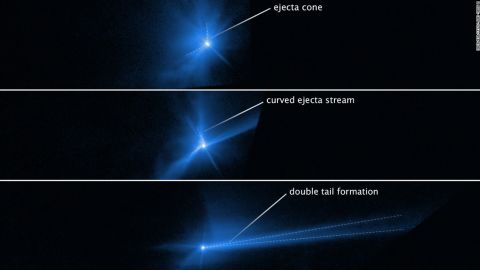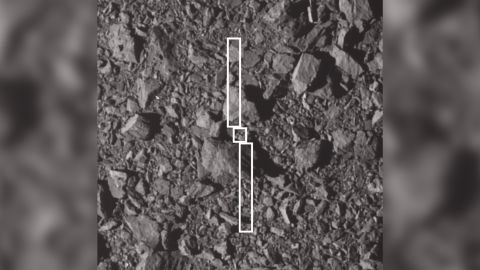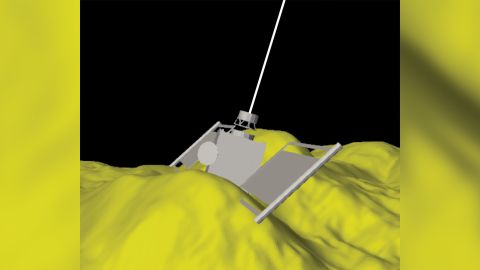Sign up for CNN’s Wonder Theory science newsletter. Explore the universe with news on fascinating discoveries, scientific advancements and more.
When a NASA spacecraft intentionally crashed into an asteroid on September 26, the collision caused the space rock to release a cometlike tail.
An array of telescopes, including the Hubble Space Telescope, were perfectly positioned to capture the DART, or Double Asteroid Redirection Test, mission and its aftermath, which continues to surprise astronomers five months later.
Hubble’s “movie” stitches together images taken during a period that started more than an hour before the collision and ended October 8. In the clip, released by NASA on Wednesday, debris can be seen flying away from the asteroid. Rotating pinwheel-shaped features become visible once the asteroid’s orbit distorts the original cone shape of the debris.
The DART spacecraft, weighing about 1,200 pounds (544 kilograms), slammed head on into the asteroid Dimorphos at 13,000 miles per hour (20,921 kilometers per hour), in an attempt to change the space rock’s velocity.
It was the first time humanity has attempted to change the movement of a celestial object, and the results show how this kinetic impact technology could be used to deflect asteroids that may ever appear to be on a collision course with Earth. Neither Dimorphos, nor the larger asteroid it orbits named Didymos, pose a threat to Earth.
The DART impact was successful, changing Dimorphos’ orbital period around Didymos by 33 minutes, according to one of five new studies published Wednesday in the journal Nature that describe the aftermath of the event.

‘Active asteroid’: Dimorphos after impact
The Hubble clip reveals how the collision turned Dimorphos into an “active asteroid,” a space rock that orbits like an asteroid but has a tail of material like a comet, according to NASA.
The initial impact, which obliterated the DART spacecraft, sprayed over 1,000 tons of dust and rock off the asteroid and sent it hurtling into space. The debris sprayed away from the asteroid in the shape of a cone, which became twisted by the asteroid’s orbit as it circled Didymos.
Then, the debris formed a cometlike tail that streamed behind Dimorphos. Unexpectedly, the tail split into two just a few weeks after the impact.
“The DART impact happened in a binary asteroid system. We’ve never witnessed an object collide with an asteroid in a binary asteroid system before in real time, and it’s really surprising. I think it’s fantastic. Too much stuff is going on here. It’s going to take some time to figure out,” said Jian-Yang Li of the Planetary Science Institute in Tucson, Arizona, and lead author of one of the new Nature studies, in a statement.

“This is really unique for this particular incident,” Li said. “When I first saw these images, I couldn’t believe these features. I thought maybe the image was smeared or something.”
DART and the future of planetary defense
One of the contributing factors to DART’s success was the recoil generated when material blasted off of the asteroid into space. The spacecraft’s impact alone wouldn’t have generated the momentum change that Dimorphos experienced, according to the researchers.
“To serve as a proof-of-concept for the kinetic impactor technique of planetary defense, DART needed to demonstrate that an asteroid could be targeted during a high-speed encounter and that the target’s orbit could be changed. DART has successfully done both,” the authors wrote in the study.
Researchers from the SETI Institute and citizen scientists participating in the Unistellar telescope network also observed the DART impact and watched as the binary asteroid system brightened suddenly by a factor of 10. The observers published their results in a Nature paper on Wednesday.

Although there is no known current asteroid threat to Earth, the new Nature studies show that missions like DART are capable of protecting our planet from space rocks.
“I cheered when DART slammed head on into the asteroid for the world’s first planetary defense technology demonstration, and that was just the start,” said Nicola Fox, associate administrator for the Science Mission Directorate at NASA, in a statement.
“These findings add to our fundamental understanding of asteroids and build a foundation for how humanity can defend Earth from a potentially hazardous asteroid by altering its course.”
Article From & Read More ( Hubble Space Telescope captured 'movie' of spacecraft slamming into asteroid - CNN )https://ift.tt/Rl3sfE2
Science
No comments:
Post a Comment